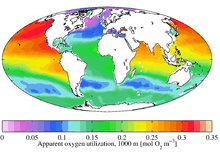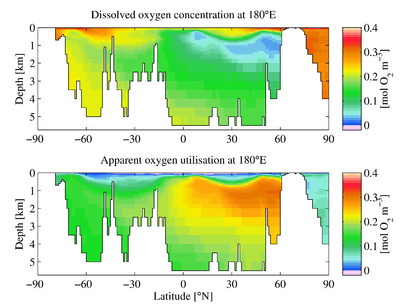Apparent oxygen utilisation
In freshwater or marine systems apparent oxygen utilization (AOU) is the difference between oxygen gas solubility (i.e. the concentration at saturation) and the measured oxygen concentration in water with the same physical and chemical properties.[1] Such differences typically occur when biological activity acts to change the ambient concentration of oxygen. For example, primary production liberates oxygen and increases its concentration, while respiration consumes it and decreases its concentration.


Consequently, the AOU of a water sample represents the sum of the biological activity that the sample has experienced since it was last in equilibrium with the atmosphere. In shallow water systems (e.g. lakes), the full water column is generally in close contact with the atmosphere, and oxygen concentrations are typically close to saturation, and AOU values are near zero. In deep water systems (e.g. oceans), water can be out of contact with the atmosphere for extremely long periods of time (years, decades, centuries) and large positive AOU values are typical. On occasion, where near-surface primary production has raised oxygen concentrations above saturation, negative AOU values are possible (i.e. oxygen has not been utilized to below saturation concentrations).
See also
References
- Garcia, H.E., Locarnini, R.A., Boyer, T.P. and Antonov, J.I. (2006). World Ocean Atlas 2005 Volume 3: Dissolved Oxygen, Apparent Oxygen Utilization, and Oxygen Saturation. S. Levitus, Ed. NOAA Atlas NESDIS 63, U.S. Government Printing Office, Washington, D.C., 342 pp.